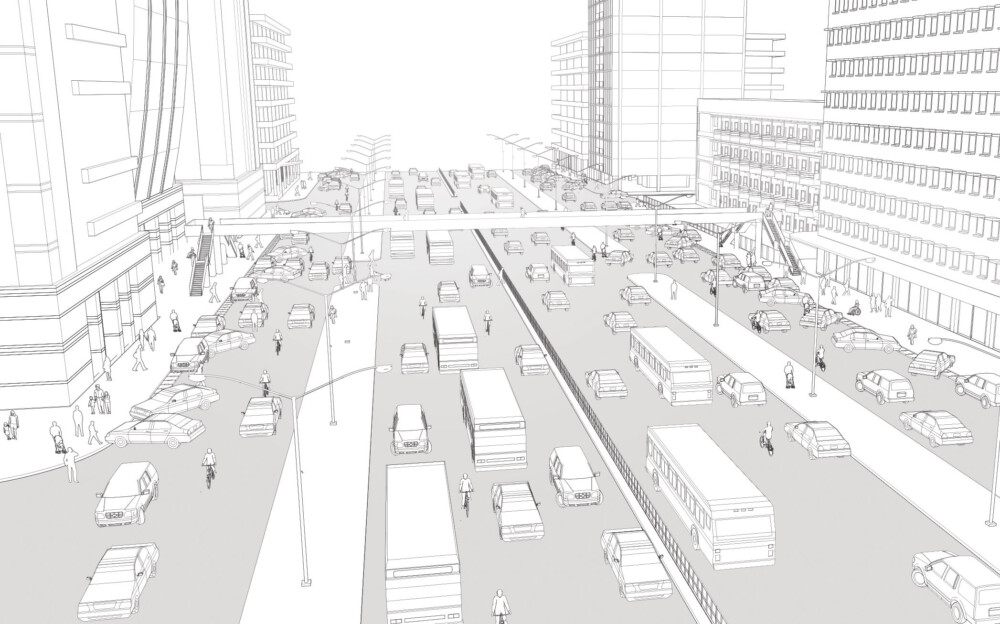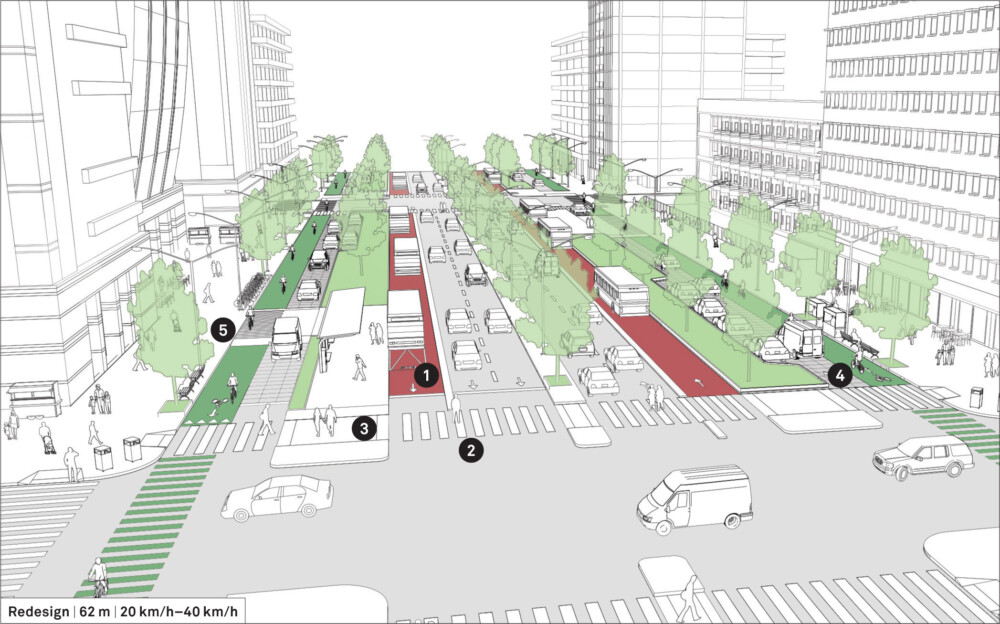-
About Streets
- Introduction
- Defining Streets
-
Shaping Streets
- The Process of Shaping Streets
- Aligning with City and Regional Agendas
- Involving the Right Stakeholders
- Setting a Project Vision
- Communication and Engagement
- Costs and Budgets
- Phasing and Interim Strategies
- Coordination and Project Management
- Implementation and Materials
- Management
- Maintenance
- Institutionalizing Change
- Measuring and Evaluating Streets
-
Street Design Guidance
- Designing Streets for Great Cities
- Designing Streets for Place
-
Designing Streets for People
- Utilities and Infrastructure
- Operational and Management Strategies
- Design Controls
-
Street Transformations
- Streets
-
Intersections
- Intersection Design Strategies
- Intersection Analysis
- Intersection Redesign
- Mini Roundabout
- Small Raised Intersection
- Neighborhood Gateway Intersection
- Intersection of Two-Way and One-Way Streets
- Major Intersection: Reclaiming the Corners
- Major Intersection: Squaring the Circle
- Major Intersection: Cycle Protection
- Complex Intersection: Adding Public Plazas
- Complex Intersection: Improving Traffic Circles
- Complex Intersection: Increasing Permeability
- Resources
Global Street Design Guide
-
About Streets
- Introduction
- Defining Streets
-
Shaping Streets
Back Shaping Streets
- The Process of Shaping Streets
- Aligning with City and Regional Agendas
- Involving the Right Stakeholders
- Setting a Project Vision
- Communication and Engagement
- Costs and Budgets
- Phasing and Interim Strategies
- Coordination and Project Management
- Implementation and Materials
- Management
- Maintenance
- Institutionalizing Change
-
Measuring and Evaluating Streets
Back Measuring and Evaluating Streets
-
Street Design Guidance
-
Designing Streets for Great Cities
Back Designing Streets for Great Cities
-
Designing Streets for Place
Back Designing Streets for Place
-
Designing Streets for People
Back Designing Streets for People
- Comparing Street Users
- A Variety of Street Users
-
Designing for Pedestrians
Back Designing for Pedestrians
- Designing for Cyclists
-
Designing for Transit Riders
Back Designing for Transit Riders
- Overview
- Transit Networks
- Transit Toolbox
-
Transit Facilities
Back Transit Facilities
-
Transit Stops
Back Transit Stops
-
Additional Guidance
Back Additional Guidance
-
Designing for Motorists
Back Designing for Motorists
-
Designing for Freight and Service Operators
Back Designing for Freight and Service Operators
-
Designing for People Doing Business
Back Designing for People Doing Business
-
Utilities and Infrastructure
Back Utilities and Infrastructure
- Utilities
-
Green Infrastructure and Stormwater Management
Back Green Infrastructure and Stormwater Management
-
Lighting and Technology
Back Lighting and Technology
-
Operational and Management Strategies
Back Operational and Management Strategies
- Design Controls
-
Street Transformations
-
Streets
Back Streets
- Street Design Strategies
- Street Typologies
-
Pedestrian-Priority Spaces
Back Pedestrian-Priority Spaces
-
Pedestrian-Only Streets
Back Pedestrian-Only Streets
-
Laneways and Alleys
Back Laneways and Alleys
- Parklets
-
Pedestrian Plazas
Back Pedestrian Plazas
-
Pedestrian-Only Streets
-
Shared Streets
Back Shared Streets
-
Commercial Shared Streets
Back Commercial Shared Streets
-
Residential Shared Streets
Back Residential Shared Streets
-
Commercial Shared Streets
-
Neighborhood Streets
Back Neighborhood Streets
-
Residential Streets
Back Residential Streets
-
Neighborhood Main Streets
Back Neighborhood Main Streets
-
Residential Streets
-
Avenues and Boulevards
Back Avenues and Boulevards
-
Central One-Way Streets
Back Central One-Way Streets
-
Central Two-Way Streets
Back Central Two-Way Streets
- Transit Streets
-
Large Streets with Transit
Back Large Streets with Transit
- Grand Streets
-
Central One-Way Streets
-
Special Conditions
Back Special Conditions
-
Elevated Structure Improvement
Back Elevated Structure Improvement
-
Elevated Structure Removal
Back Elevated Structure Removal
-
Streets to Streams
Back Streets to Streams
-
Temporary Street Closures
Back Temporary Street Closures
-
Post-Industrial Revitalization
Back Post-Industrial Revitalization
-
Waterfront and Parkside Streets
Back Waterfront and Parkside Streets
-
Historic Streets
Back Historic Streets
-
Elevated Structure Improvement
-
Streets in Informal Areas
Back Streets in Informal Areas
-
Intersections
Back Intersections
- Intersection Design Strategies
- Intersection Analysis
- Intersection Redesign
- Mini Roundabout
- Small Raised Intersection
- Neighborhood Gateway Intersection
- Intersection of Two-Way and One-Way Streets
- Major Intersection: Reclaiming the Corners
- Major Intersection: Squaring the Circle
- Major Intersection: Cycle Protection
- Complex Intersection: Adding Public Plazas
- Complex Intersection: Improving Traffic Circles
- Complex Intersection: Increasing Permeability
- Resources
- Guides & Publications
- Global Street Design Guide
- Streets
- Avenues and Boulevards
- Grand Streets
- Example 2: 62 m
Example 2: 62 m


Existing Conditions
The large city street illustrated above carries fast-moving through-traffic in the central travel lanes and local traffic mixed with double parking in the side running service lanes. A fenced median limits pedestrian cross-street access.
Collective transport operates in mixed traffic in the center through-lanes. Congestion reduces transit service quality and reliability. Transit riders wait on the side medians with no shelter or protection.
Irregular parking encroaches upon the sidewalk, constraining the already limited pedestrian space and reducing capacity for social and economic activities. Pedestrians are exposed to unsafe and harsh walking environments due to inaccessible and disconnected sidewalks, fast-turning traffic, lack of pedestrian crossings, and absence of landscaping and trees.
Fences on the central median, intended to restrict pedestrian behavior, often result in pedestrians crossing unsafely by jumping over or cutting through the fence.
Crossings are grade separated by overhead foot bridges or underpasses that significantly add to pedestrian travel time and are not universally accessible.
Poor drainage infrastructure causes flooding during heavy rains, and open culverts create a safety hazard for vulnerable users.

Ho Chi Minh City, Vietnam

Medellín, Colombia
Design Guidance
Convert one travel lane in each direction into a dedicated transit lane, and widen the medians to introduce multiple refuge islands. This creates a safer street with a more efficient transit system.
![]() Provide a fully separated bus lane in a dedicated transitway with curb separation. At moderate to frequent headways, the transitway vastly improves average transit speed and reduces travel time variation.
Provide a fully separated bus lane in a dedicated transitway with curb separation. At moderate to frequent headways, the transitway vastly improves average transit speed and reduces travel time variation.
Design transit stops as accessible boarding islands for increased efficiency and comfort. Install covered structures to provide a sheltered and comfortable waiting space for passengers. See: Transit Stops.
![]() Add ground markings and low dividers to distinguish and separate transit lanes from other traffic. When occasional vehicle access into the transit lane is needed, use low vertical separation elements such as mountable curbs. To permanently prevent access into the transit lanes, use prominent vertical elements like bollards, which require added width. Provide additional enforcement while traffic behavior adjusts to new configurations.
Add ground markings and low dividers to distinguish and separate transit lanes from other traffic. When occasional vehicle access into the transit lane is needed, use low vertical separation elements such as mountable curbs. To permanently prevent access into the transit lanes, use prominent vertical elements like bollards, which require added width. Provide additional enforcement while traffic behavior adjusts to new configurations.
Widen sidewalks and medians to provide universal access and increase space for pedestrian and commercial activity.
![]() Install refuge islands to shorten the crossing distance for pedestrians and provide frequent at-grade signalized crossings to allow pedestrians to safely and conveniently cross the street. See: Pedestrian Refuges.
Install refuge islands to shorten the crossing distance for pedestrians and provide frequent at-grade signalized crossings to allow pedestrians to safely and conveniently cross the street. See: Pedestrian Refuges.
Manage cross-traffic turns to improve the safety and reliability of the through lanes by removing conflicts and speed differentials.
![]() Convert service lanes to slower, pedestrian and cycle-friendly streets at 20 km/h with a cycle lane in each direction. See: Design Speed.
Convert service lanes to slower, pedestrian and cycle-friendly streets at 20 km/h with a cycle lane in each direction. See: Design Speed.
![]() Raise crossings for service lanes at the intersections to allow safe access from the sidewalk to the transit stop.
Raise crossings for service lanes at the intersections to allow safe access from the sidewalk to the transit stop.
Add trees and landscaping to provide shade, reduce the urban heat island effect, capture stormwater, and improve the air quality.

Buenos Aires, Argentina
Adapted by Global Street Design Guide published by Island Press.
Next Section —